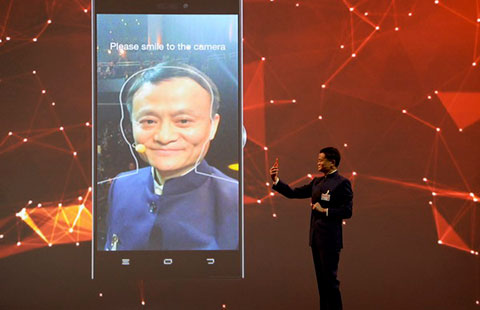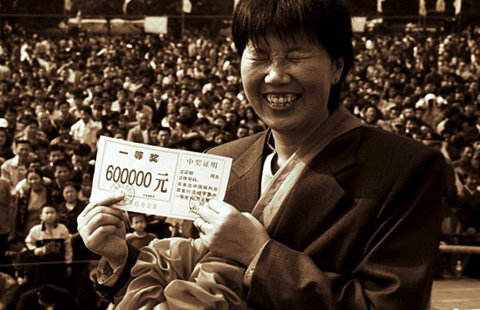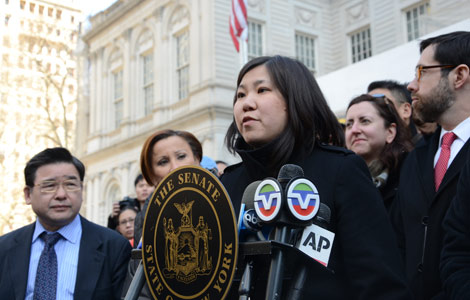Riding back into the past on New York City's subway system
Updated: 2015-03-09 11:02
By Chen Weihua(China Daily USA)
|
||||||||
It might be annoying to hear too many people talking on their cell phones in Shanghai's subway, but I became a bit desperate one day lately while riding the subway in New York, as there was no signal throughout the 40-minute ride and I wanted to inform a friend that I would be late for our meeting.
Years ago, coming from Shanghai where there is always a cellular signal available on the underground rail system, I was already puzzled why this great American city had no cell-phone signal in its otherwise very efficient subway system. 
In an age in which people want to be connected all the time, New Yorkers seem to still live in the last century once they venture below ground.
Don't get me wrong. I actually love the 111-year-old New York subway system, which, unlike my hometown Shanghai or Washington where I live now, operates 24/7. The designs at various stations give a strong sense of history and each station has its own fascinating story. I love the bands and musicians playing at Times Square and Herald Square stations, my daily stops for a few years.
One of my favorite museums is the New York Transit Museum in Brooklyn, with subway cars from the last 100 years on display. I actually rode on an old subway car from the 1920s from Midtown to Upper West Side about three years ago.
But that doesn't mean the New York subway system should stay in the 1920s in terms of communication. It is certainly not rocket science for a nation that sent people to the moon, and it would cost only a fraction of the estimated $4 trillion the United States spent on wars in Iraq and Afghanistan.
When years ago I asked an American friend why New Yorkers would tolerate such a reality, he said probably most New Yorkers don't even know that you could get cellphone signals underground.
But people got to know that in September 2011, when for the first time six New York subway stations started to offer cellular services, although the signal was only available on platforms, not in the tunnels.
If that signified a turning point for New York's subway system to enter the 21st century, the pace has been sadly slow in the past few years.
In April 2013, New York Governor Andrew Cuomo announced that 30 additional underground stations would have cell-phone service, bringing the total to 36. It was the first time that the signal was available in the Times Square station, probably the busiest among all 468 stations.
And in Octoberlast year, it was announced that 40 additional subway stops, on top of the previous 36, would offer cellular and mobile data access by the year-end.
The remaining underground subway stations are slated to receive cell and Internet services by 2017.
By the way, that means the stations, not the tunnels. There seems to be no plan so far to provide cellphone connectivity to the complete subway system.
One friend joked that current situation has become the very best excuse he could use not answering his boss' phone call because he is underground.
The other who is angry about that situation complained that it is because the rich and powerful in New York have their own cars or take cabs, and rarely use the subway.
New York is not alone. Washington also provides cellular service only in the stations, not when trains go into tunnels.
I became a bit desperate a week ago not just because I was unable to tell my friend I would be late for our meeting, but also because I could sense the despair people must feel when they really need to make an emergency call or stay closely connected with the world above.
Contact the writer at chen weihua@chinadailyusa.com

 The CeBIT trade fair opens in Germany
The CeBIT trade fair opens in Germany
 Now and then: Lottery dream fading
Now and then: Lottery dream fading
 Braving the snow for greener pastures
Braving the snow for greener pastures
 Special: Preserve the past to live the future
Special: Preserve the past to live the future
 Bruce Lee's legacy promotes Kungfu in LatAm
Bruce Lee's legacy promotes Kungfu in LatAm
 Germany's Black Forest: a popular holiday destination
Germany's Black Forest: a popular holiday destination
 Push for Lunar New Year school holiday
Push for Lunar New Year school holiday
 Sea of color at Shenzhen race
Sea of color at Shenzhen race
Most Viewed
Editor's Picks

|

|

|

|

|

|
Today's Top News
Mutual respect, interests key to US relations
US targets vocational schools in visa crackdown
Washington pitched to tourist
China, Myanmar investigate deadly bombing in Yunnan: FM
Foreign investment restrictions
to be cut
Taking the fight to the terrorists
Action to be taken if deadly bombing happens again
New bureau set to boost graft fight
US Weekly

|

|








